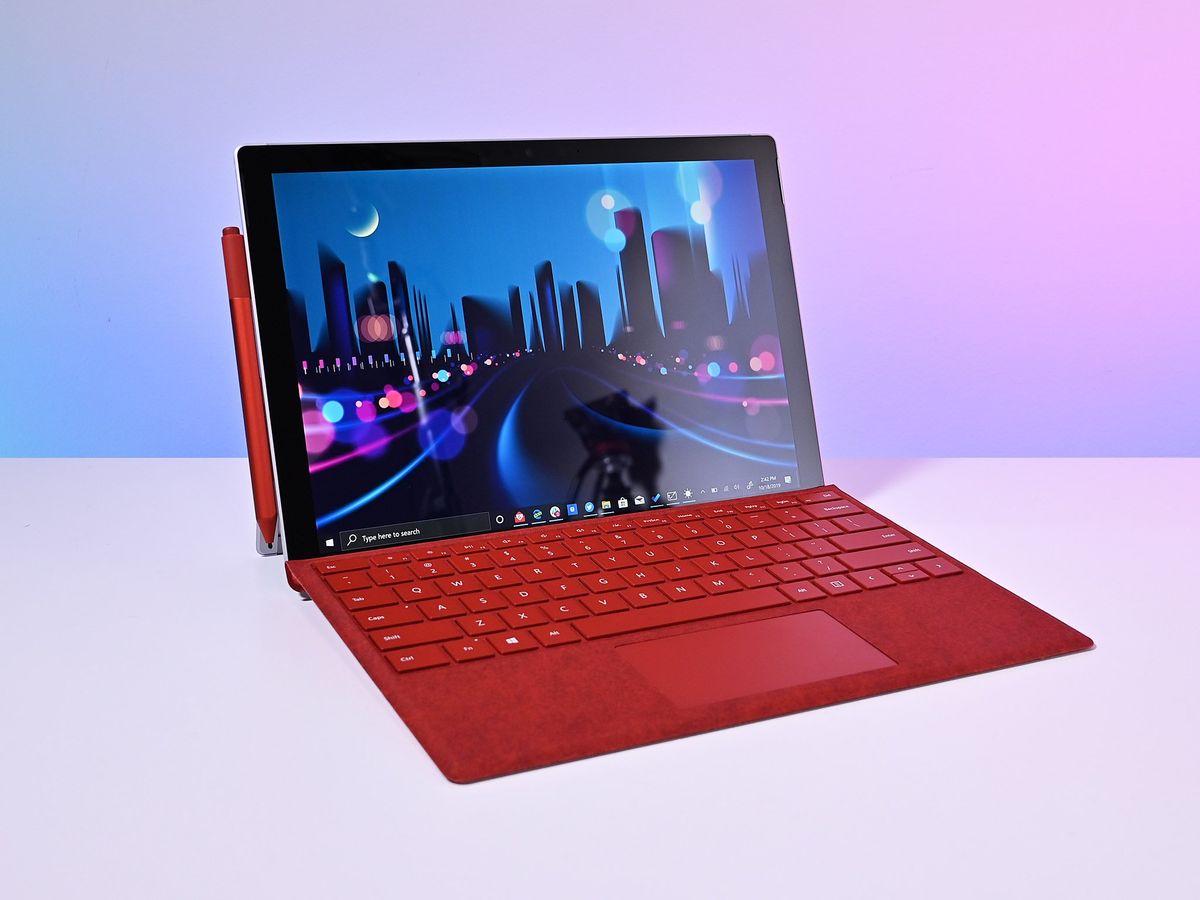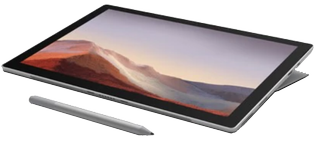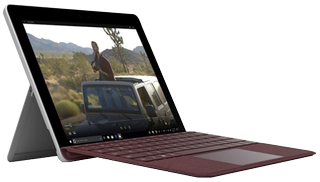

Latest Surface Pro
The Surface Pro 7 costs significantly more than the Surface Go, but if you need a performance 2-in-1, this is it. 10th Gen Intel Core "Ice Lake" CPU options and LPDDR4x RAM offer impressive speed, and you get a larger display with inking capabilities. It's not as portable and doesn't have optional LTE, but this is the pick for power users.
For
- Far better performance for intensive tasks
- Larger, higher-res touch display
- Now with USB-C port
- Works with older Type Covers
- Available in black and platinum
Against
- No optional LTE
- Not as portable
- More expensive

Lighter, less powerful 2-in-1
You'll save a lot of money by going with the Surface Go, but it's more of a 2-in-1 intended for casual use. It still has a high-res touch display with inking, optional LTE is available, and it has a USB-C port, but it won't match the performance or battery life you'll find in the Pro 7.
For
- More portable than the Pro 7
- Much more affordable
- Optional LTE available
- USB-C port included
- High-res touch display
Against
- Not as powerful as the Pro 7
- Battery life not as impressive
These two Surface devices both live up to a high expectation of quality and design. Though they're both portable, the Go is undoubtedly meant to be a device you can tuck under your arm for casual computing, while the Pro 7 is more of a powerhouse 2-in-1 that promotes versatile performance. Let's take a look at the specs to see how these two devices differ.
Surface Pro 7 vs. Surface Go tech specs
| Header Cell - Column 0 | Surface Pro 7 | Surface Go |
|---|---|---|
| OS | Windows 10 | Windows 10 |
| Processor | 10th Gen IntelCore i3-1005G1Core i5-1035G4Core i7-1065G7 | Intel Pentium Gold 4415Y |
| RAM | 4GB, 8GB, 16GB LPDDR4x | 4GB, 8GB LPDDR3 |
| Storage | 128GB, 256GB, 512GB, 1TB SSD | 64GB eMMC128GB SSD |
| Display size | 12.3 inchesTouch | 10 inchesTouch |
| Display resolution | 2736x1824267 PPI | 1800x1200217 PPI |
| Aspect ratio | 3:2 | 3:2 |
| Graphics | Intel UHD (i3)Intel Iris Plus (i5, i7) | Intel HD Graphics 615 |
| Ports | USB-C 3.1USB-A3.5mm audioSurface ConnectmicroSD card reader | USB-C 3.1microSD card reader3.5mm audioSurface Connect |
| LTE | No | Optional |
| Camera | Front-facing 5MP (1080p)Rear-facing 8MP (1080p) | Front-facing 5MP (1080p)Rear-facing 8MP (1080p) |
| Biometrics | IR camera | IR camera |
| Battery | Up to 10.5 hours | Up to 9 hours26Wh |
| Dimensions | 11.5 x 7.9 x 0.33 inches(292mm x 201mm x 8.5mm) | 9.65 x 6.90 x 0.33 inches(245mm x 175mm x 8.3mm) |
| Weight | From 1.7 pounds (775g) | From 1.15 pounds (522g) |
Design and features
The Surface Pro 7 doesn't stray far from the Pro design we've come to expect. It brings a slim tablet chassis with folding kickstand on the back, removable Type Cover keyboard and Precision touchpad, and brilliant touch display with inking support for the Surface Pen.
Most of the real changes to the Pro 7 come on the inside, though one advancement we're welcoming is the addition of a USB-C port for added connectivity. The Pro 7 still holds onto a USB-A port (which the Go lacks), as well as Surface Connect, a microSD card reader, and a 3.5mm audio jack.
The Surface Go is a smaller, more portable version of the Pro. It sacrifices performance and battery life for portability, but it's still a premium Surface device that lives up to the set standard. It's the same thickness as the Pro 7, which makes it seem a bit chunkier due to the overall smaller footprint, and it has a rotating kickstand on the back to prop up the tablet. It also works with a Type Cover if you'd like to add a Precision touchpad and keyboard, and the high-res touch display is compatible with the Surface Pen for a great inking experience.
The Pro 7 does not have optional LTE connectivity for staying in touch wherever you go. For that feature, you'll have to opt for the LTE-enabled Surface Go, which costs about $679. Thanks to the 10th Gen Intel Core CPUs, the Pro 7 does offer Wi-Fi 6 connectivity for blistering wireless speeds where available.
Ultimately, if you're looking for the most portable 2-in-1 between these two Surface products, the Go is your best bet. However, if you're interested in optimal performance or the best inking experience possible, the Pro 7 can't lose.
Display and inking
The Pro 7's 12.3-inch display is essentially the same as the Pro 6, with a 3:2 aspect ratio, 267 PPI, and 2736x1824 resolution. It offers a brilliant picture, and the larger size allows for easier multitasking compared to the Go. The Surface Pen with the Pro 7 offers a natural inking experience, with 4,096 levels of pressure sensitivity and tilt function. It is also compatible with the Surface Dial, but only for off-screen interactions.
Get the Windows Central Newsletter
All the latest news, reviews, and guides for Windows and Xbox diehards.
The Go's smaller 10-inch touch display is no slouch, with a 3:2 aspect ratio, 217 PPI, and 1800x1200 resolution. It also offers 4,096 levels of pressure sensitivity and tilt support, as well as off-screen Surface Dial interactions. The Go does not have the same co-processor for lower latency, however, so the overall inking experience isn't going to match up with the larger, pricier Surface Pro 7. The Go is great for jotting notes and making sketches, but for those with serious artistic ambition in mind, the Pro 7 should be a much better fit.
Performance and price
The portable Surface Go isn't meant to be a powerhouse, and the hardware options reflect that. The Intel Pentium Gold 4415Y CPU is a dual-core chip that's cut out for productivity and some light gaming, but it's not going to get you into any specialized work. To compare, it performs just below a Surface Pro 4 with Core m3 CPU in terms of raw processing power.
You can add 4GB or 8GB of RAM to the Go depending on your budget and performance needs, and there's likewise the option for 64GB of eMMC storage or a 128GB SSD. The eMMC storage is quite slow, so if you have room in the budget, we recommend jumping up to the 128GB mark. The baseline Go, with 64GB storage, 4GB of RAM, and Pentium CPU costs about $389, far less than the entry Pro 7 model. If you're interested in 128GB of SSD storage, 8GB of RAM, and LTE connectivity, the price jumps up to about $679.
Geekbench 5
Geekbench 5.0 (CPU) (Higher is better)
| Device | CPU | Single core | Multi core |
|---|---|---|---|
| Surface Pro 7 | i5-1035G4 | 1,191 | 4,441 |
| Surface Pro 6 | i7-8650U | 1,113 | 3,519 |
| Surface Pro 6 | i5-8250U | 904 | 3,440 |
| Surface Laptop 3 | Ryzen 5 | 769 | 2,720 |
| Dell XPS 13 2-in-1 7390 | i7-1065G7 | 1,209 | 3,571 |
| Dell XPS 15 7590 | i9-9980HK | 1,176 | 7,624 |
Geekbench 4
Geekbench 4.0 (CPU) (higher is better)
| Device | CPU | Single core | Multi core |
|---|---|---|---|
| Surface Pro 7 | i5-1035G4 | 5,245 | 17,350 |
| Surface Go | Pentium | 2,078 | 3,934 |
| Surface Pro 6 | i7-8650U | 5,037 | 13,864 |
| Surface Pro 6 | i5-8250U | 4,287 | 14,031 |
| Surface Pro 5 | i5-7300U | 4,302 | 8,482 |
| Surface Pro 5 | i7-7660U | 4,513 | 9,346 |
| Surface Pro 4 | i5-6300U | 3,319 | 6,950 |
PCMark
PCMark 10
| Device | Score |
|---|---|
| Surface Pro 7 i5 | 3,992 |
| Surface Pro 6 i7 | 3,644 |
| Surface Pro 6 i5 | 3,501 |
| Surface Laptop 3 15 | 4,006 |
| Dell XPS 13 2-in-1 7390 | 4,427 |
| Dell XPS 15 7590 | 5,521 |
| Dell XPS 13 2-in-1 7390 | 4,427 |
| Dell Inspiron 13 7390 2-in-1 | 3,764 |
| HP Pavilion x360 14 | 3,558 |
| Lenovo ThinkBook 13s | 3,468 |
GPU
Geekbench 5.0 OpenCL (higher is better)
| Device | GPU | Compute score |
|---|---|---|
| Surface Pro 7 | Iris Plus | 7,613 |
| Surface Pro 6 | Intel UHD 620 | 5,396 |
| Surface Laptop 3 15 | Vega 9 | 11,334 |
| Dell XPS 13 2-in-1 7390 | Iris Plus | 10,406 |
| Dell Inspiron 13 7390 2-in-1 | Intel HD | 5,632 |
| Dell Precision 3541 | NVIDIA Quadro P620 | 12,469 |
SSD
CrystalDiskMark (Higher is better)
| Device | Read | Write |
|---|---|---|
| Surface Pro 7 | 2,040 MB/s | 809 MB/s |
| Surface Go (SSD) | 1,185 MB/s | 133 MB/s |
| Surface Go (eMMC) | 260 MB/s | 145 MB/s |
| Surface Pro 6 | 1,632 MB/s | 814 MB/s |
| Surface Pro 5 | 847MB/s | 801 MB/s |
| Surface Laptop 3 | 2,028 MB/s | 806 MB/s |
| Surface Laptop 2 | 1,509 MB/s | 811 MB/s |
| Surface Laptop | 486 MB/s | 244 MB/s |
| Surface Book | 1,018 MB/s | 967 MB/s |
.
The Surface Pro 7, which starts at about $883, is much better cut out for heavy multitasking, gaming, and even some specialized work. 10th Gen Intel Core i5 and i7 "Ice Lake" CPUs are going to offer the best performance (Iris Plus graphics are impressive), but if you're on a tight budget, the Core i3 model will still beat out the Pentium Gold chip in the Go.
You can outfit a Pro 7 with up to 16GB of RAM and a 1TB SSD, making it much more prepared for life as your only device. Price does play a far more obvious role here, though, as decked-out models with Core i7 CPU, 16GB of RAM, and 1TB SSD cost about $2,300. Battery life from the Core i5 Pro 7 hits eight hours from a charge.
Go with the Surface Pro 7 for best performance
Thanks to 10th Gen Intel Core "Ice Lake" CPUs, up to 16GB of RAM, and up to a 1TB SSD, the Surface Pro 7 is ready to tackle a heavy workload. It also delivers a better inking experience, and its larger display is better designed for multitasking. However, it does cost quite a bit more than the Go and does not include optional LTE connectivity.

Now with USB-C and 10th Gen Intel Core CPUs
The Surface Pro 7 has been refreshed with 10th Gen Intel Core i3, i5, and i7 "Ice Lake" CPU options for improved performance, and it offers USB-C for added connectivity.
The Surface Go offers ideal portability
The Surface Go might not offer the same level of performance or quite the same inking experience, but it costs a lot less and still reigns as an ultraportable 2-in-1 with optional LTE connectivity. It's likely best used as a secondary device — one that you can shove in a bag or under an arm when heading out the door — but it can certainly as your lone companion if you're mostly tackling productivity work.

Cale Hunt brings to Windows Central more than eight years of experience writing about laptops, PCs, accessories, games, and beyond. If it runs Windows or in some way complements the hardware, there’s a good chance he knows about it, has written about it, or is already busy testing it.